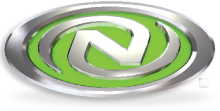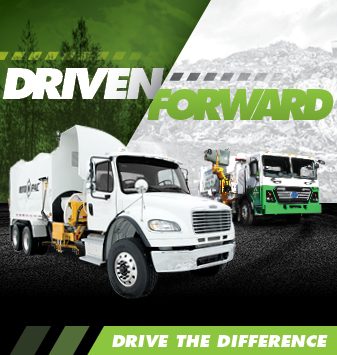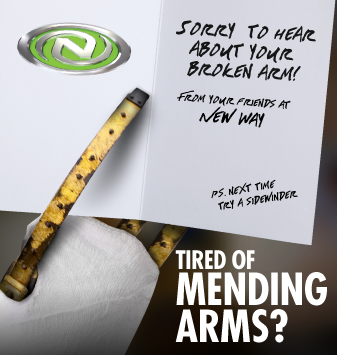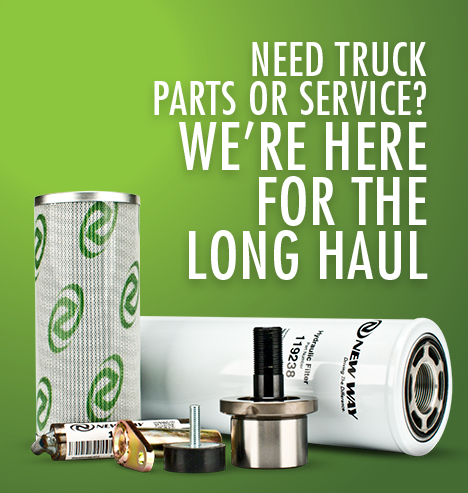New Horizons
New technology in collection trucks helps to address a number of issues, from job recruitment to route optimization.
12.15.2016
Carol Brzozowski
MSW Management, January/February 2017 Issue
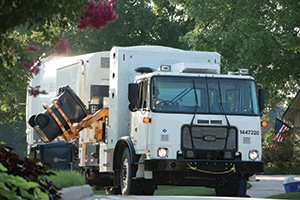
Throughout the market, municipal solid waste (MSW) collection vehicle manufacturers are offering various cutting-edge technologies and hint at possible changes that may translate from “science fiction” to reality.
Bill Steiner, director of the Portage County (Ohio) Solid Waste Management District, believes changes in collection vehicles need to be based on input from the people driving the trucks. “At the director level, it’s my job to make sure we get the trucks, they work well, and they’re the best value for the money we’ve spent. But I don’t drive them,” he points out. “I get to know what they like and don’t like, and what we can do to make their jobs at lot easier.”
So when Steiner sought to replace several aging vehicles in his operation’s fleet, he pulled together people from Autocar Truck, Parker-Hannifin, and his mechanic for a meeting.
“I looked at the mechanic and said, ‘This gentleman outvotes me here because he’s a former driver and a mechanic. He works on these things—he knows these trucks even better than what I can hope to. The job is to get what he wants.’
“We came away with some very nice trucks,” he adds. “We try to get trucks with air ride suspension for the drivers, which makes going over railroad tracks [easier], and here in northeast Ohio we do have a few bumpy roads because we do have winter, so we’re looking at that as well.”
The Portage County Solid Waste Management District’s 22 employees serve some 161,000 people throughout the county, with the exception of three small communities. The operation puts 14 trucks on the road each day for curbside, drop-off, and commercial tasks.
The Portage County Solid Waste Management District’s fleet is a mix of older vehicles ranging between 12 and 15 years old, and newer vehicles, including five recently purchased 2016 Autocar Truck trucks, with a sixth one on order.
Like many MSW operations, Steiner’s looks for new technologies that are on the forefront of collection vehicle technology to help not only with day-to-day solid waste collection, but to mitigate one of the nagging problems plaguing the industry: finding willing and qualified collection vehicle drivers.
Having trucks with “creature comforts” is one way to address that, he points out.
“What better way to attract people than tell them when you’re hiring them that you’re going to be inside of a truck and do not have to get out of it. The arm is going to do all of the work,” he says.
The Portage County Solid Waste Management District is transitioning from 18-gallon bins to 95- and 65-gallon toters, and automation for its residential pickup.
As such, Steiner notes he is looking to replace the older trucks within the next year and will stick with the Autocar Truck cab and chassis.
The Portage County Solid Waste Management District is choosing to go with a front-load residential collection truck with a Curotto Can on the front for its more rural collection areas and an automated side loader with the Parker-Hannifin RunWise Advanced Series Hybrid Drive system on them.
“Those have been a game changer for us,” notes Steiner.
The department had the second-highest Excess Workers’ Compensation claims behind the Sheriff’s Department because of the hundreds of times a day drivers had to get in and out of trucks to pick up bins.
“Now it has dropped significantly, and the efficiency factor—where before we had maybe four trucks do two different communities—we’re now down to two.”
Route optimization also is being planned. “That will create even more efficiency,” says Steiner. “We wanted to get away from having the drivers get out in all kind of weather. We figure we would let the truck do the work instead of the driver.”
There are certain elements Steiner seeks in a collection truck, with “creature comforts” being high on the list. “I’m about six [foot] one [inch], and when I crawl up into the truck I find them to be quite comfortable,” he says. “I like the layout of Autocar Truck trucks.”
Steiner looks forward to innovation going forward that will do even more to improve collection efforts and attract employees. “If we can find a way so it’s not constantly a joystick, because the next thing that will happen is the industry will probably get hit with a bunch of carpel tunnel claims,” he says.
When Steiner looks to purchase a collection vehicle, he starts by looking at demonstrations at factories. He says he was impressed by Autocar Truck’s “detail to quality control and customer service.”
While new technology can be an attractive pull for MSW operations, affording it is a prime concern.
The Portage County Solid Waste Management District recently purchased 25,000 carts and four out of the five Autocar Truck trucks through the Closed Loop Fund. The program provides zero-interest loans to cities and below market loans to companies for recycling infrastructure.
“We were one of the first public entities in the nation to take advantage of that,” he says. “It’s something we’re very proud of. It was more than a $3 million loan, seven years interest-free. That was a huge, huge game changer for the district. I cannot say enough things about Closed Loop and what they’re doing for the industry.”
The operation’s fifth- and sixth-newest trucks were purchased with Ohio Environmental Protection Agency Community Development grants, $200,000 and $173,000 respectively.
The grants enable communities to purchase items such as trucks and equipment, Steiner says.
Since his operation is converting to single stream, it drives up diversion rates, which is one of the Ohio EPA’s goals, he points out. “We’ve been doing curbside recycling since 1993,” says Steiner. “We’re the largest district in the state of Ohio. They look at us as one of the poster children for curbside recycling to be done by a government agency.”
By converting from dual stream to single stream with its trucks, the Portage County Solid Waste Management District changed its website and the look of its trucks. “Our trucks are very distinctive,” says Steiner. “We’re making sure that every truck that we buy now has matching wraps on it. We looked down the road, spending money upfront to make sure we didn’t get hit with outrageous maintenance costs. We’re very proud of the trucks we have purchased. We have one of the nicest-looking fleets around.”
As for the newer vehicles in the operation’s fleet, Steiner has received a lot of positive feedback from the drivers who have the new trucks that they’re “very happy.”
“Our response to them is to meet us halfway, keep the trucks clean inside and out, and do the pre- and post-inspection, and we’re happy,” he says.
Autocar Truck is focusing innovative efforts on increasing safety and productivity of the trucks, reducing operating costs, enhancing vehicle service, and improving the satisfaction of MSW operators and that of their own customers, notes Adam Burck, vice president, brand management for Autocar Truck.
Tires play a major role that effort. “There are a lot of areas where tires can improve safety and reduce operating costs, and in the end reduce greenhouse gas emissions as well,” points out Burck.
He gives an example: “integrating tire pressure monitoring systems—which is not common in refuse trucks—but beyond that even going into automatic tire inflation. We can invariably change the tire inflation depending on the load of the vehicle. That helps with safety and with the ride, as well as with rolling resistance.”
Monitoring tread depths for safety and preventative maintenance and low-rolling resistance tires also increases efficiency, Burck adds.
That’s important in MSW residential collection, during which a truck starts out empty and progressively throughout the day gets fuller and fuller, causing tire inflation to change, he says.
There’s also the additional stop-and-go nature of MSW collection that may incur hundreds of pickups a day, as well as reaction to traffic conditions. “If the tire is overinflated relative to the load, that can reduce adhesion in braking defense,” he adds. “If we can dynamically change that over time, that keeps the truck’s braking distance constant. In an urban environment, anything that can avoid an accident, especially when it’s not the driver’s fault, is really important.”
Mitigating potential problems relative to distractions is also on Autocar Truck’s radar. “There are a lot of distractions in the cabs right now with all sorts of screens, cameras, monitors, cameras outside the truck, and monitors for routes,” points out Burck. “Not only are they distracting for the driver, they also are service issues when they are installed in an aftermarket basis.”
Autocar Truck offers full integration of the camera systems and the video recorders in the cab when constructing the truck on the line, and then body companies can install those devices without damaging the wiring of the truck and keeping everything organized, says Burck.
Technology also is improving service and maintenance. Burck points out that when a truck goes down on its route, it creates a cascade of disappointed customers, lost productivity, and time and financial investment in vehicle repair.
“If they don’t know what the real problem is, they send a field tech out. Then the field tech takes time and money, and then the field tech didn’t bring the right part and they have to tow it back, so we call that the service failure trifecta,” says Burck. “Three sets of constant problems that are totally avoidable.”
It’s avoidable through sophisticated onboard diagnostics that identify before the driver even knows there’s a problem what the problem is and allows the operator to contact an Autocar Trucks solutions service command center where trained mechanics can either bring the correct part out to the truck, or through live video mechanic support guide an MSW’s in-house team to fix the issue, he adds.
Expect further such integrations down the road, Burck says. “To reduce distractions, you’ll need heads-up displays so they don’t have to look down at the instruments, and maybe lane change and proximity warnings—something that automatically stops the truck,” he adds.
Another concept that may become reality: bin recognition technology so that a truck automatically knows when to start and stop and pick up the bins on the side of the road without the driver interacting, says Burck.
While one may quite cautiously regard the thought of an 80,000-pound garbage truck autonomously moving through neighborhoods without driver control, the concept of safety and productivity being improved by an automated function as such goes far in improving customer service, says Burck. “We can know that the customer’s can is ready to be picked up, and we can record that it was picked up and do that faster,” he points out. “We won’t miss anybody, and we can bill based on what’s been done, rather than just flat billing, and have more driver satisfaction so they don’t have to do these repetitive things all of the time.”
The Roto Pac is a joint venture between New Way and Ginove, a Canadian firm that designed and developed the first purpose built organics collection truck.
Phil Allen, executive vice president for sales and marketing for New Way, calls the Roto Pac the “first in the world” to offer an auger as its central operational point. “All garbage trucks up to this point operate up to a basic system of cylinders pushing a ram that pushes the trash into a body and compacts,” he says. “A front loader drops in from the roof into the hopper, and a big blade pushes it into the body. A rear loader packs from the rear and pushes it toward the front. A side load automated garbage truck packs it into a body and it compacts inside the body.”
What makes Roto Pac different is that it doesn’t use any packing blades or cylinders, but, rather, uses an auger. The garbage passes into the body to the auger, which is not only grinding it and forcing it in, but also providing high compaction rates, notes Allen.
In comparison to a conventional side loader that may pack out at 709 pounds per cubic yard, the Roto Pac is designed to do 1,222 pounds per cubic yard, says Allen. “That means the truck can go out, stay out on the route longer and possibly complete the whole route where other conventional trucks—even our own—might take two trips to the landfill to finish the route,” he says.
Other benefits: because the truck doesn’t have packing blades and cylinders, the body weighs about 3,000 pounds less than conventional-sized motors, says Allen. “You’ve got more trash and a lighter weight body. The fact that our auger will transfer seven cubic yards of material per minute into the body—that’s how fast it grinds it up and pushes it into the body—means it’s faster on the route and can pick up more in a day,” says Allen.
The body is 20 inches shorter than the standard conventional-sized loader. “It’s more maneuverable when you are on cul-de-sacs,” says Allen. “It makes it easier to travel down congested roads because it has a better turning radius.”
The Roto Pac is continuing to meet the industry’s ever-changing needs. “This was designed originally for organics collection because there is a little bit more organics collection going on in Canada than there is in the United States,” says Allen. “That’s where the auger concept comes in.
“There is a myriad of problems that result in using standard garbage trucks to pick up organics when you’re compressing tomatoes, melons, carrots, and other food with high liquid content. The stuff will get behind the mechanisms, and gum up your body because it’s not sealed and can cause leaks.”
Ginove sought to make something that was “liquid tight and would not present that problem of having to clean up behind the packing blades,” notes Allen. “With that auger, when it’s dumped at the end of the day, you take a hose and spray inside the body and drop the thing down, and you’re done.”
Aside from places like Boston and the West Coast, organics collection is not as widespread in the US as it is in Canada, Allen points out. “We thought we’d try it on MSW, and it’s been successful,” he says of the dual-purpose effort. “Say a hauler would have an organics route and a garbage route. He could go out on one day on Monday and pick up organics, and on Tuesday the same truck can go down the road and pick up MSW. It reduces the number of trucks needed on the collection routes.”
Allison Transmission’s latest products at the forefront of technology include FuelSense, a set of software packages designed to improve fuel economy up to 20%.
Features include EcoCal, which is designed to provide lower shift points to get into lock up as soon as possible, providing necessary performance without shift cycling. Dynamic Shift Sensing automatically selects between lower/higher speed shift schedules based on the vehicle’s actual payload and the grade on which it is operating. “This optimizes fuel economy while maintaining superior performance,” notes Craig Koven, Allison Transmission spokesperson.
Acceleration Rate Management mitigates aggressive driving by controlling engine torque based on the vehicle’s grade and load. Neutral At Stop is designed to automatically eliminate the load on the engine when the vehicle is at a full stop to save fuel and reduce overall vehicle emissions.
Allison Transmission’s 5th Generation Electronic Controls are designed to offer a variety of features to further improve fuel economy and maximize transmission protection with advanced prognostics.
“Calibrated to the vehicle’s particular operating requirements, Allison’s advanced prognostics monitor various operating parameters to determine and alert when service is due,” says Koven. “This eliminates unnecessary oil and filter changes, and provides maximum transmission protection.”
Features include Oil Life Monitor. Based on the vehicle’s duty cycle, this feature determines fluid life and alerts drivers when a fluid change is required.
“Not only does it help get maximum oil life while providing the maximum protection for the transmission, the Oil Life Monitor also saves money by preventing unnecessary fluid changes,” says Koven.
Filter Life Monitor provides an alert when the transmission’s fluid filters need to be replaced. “It helps extend filter change intervals to reduce routine maintenance downtime and saves money in the long run, all the while providing maximum protection for the transmission,” says Koven.
Transmission Health Monitor determines the condition of the transmission’s clutches and alerts when clutch maintenance is required. “It helps avoid costly repairs and downtime by taking the guesswork out of scheduling routine transmission maintenance,” says Koven.
Rush Enterprises offers RushCare Service Connect, a tool designed to add transparency and convenience for fleet managers and Momentum Fuel Technologies, a division of Rush Enterprises which recently launched a roof-mount CNG system designed specifically for refuse vehicles.
Momentum Fuel Technologies is a vertically integrated provider of compressed natural gas (CNG) fuel system solutions for Class 6 to Class 8 vehicles. The division has collaborated with refuse body manufacturers to offer products to meet waste industry needs.
Case in point: Momentum systems will be available on McNeilus truck bodies, among other manufacturer configurations.
Momentum Fuel Technologies recently introduced two roof-mount configurations specially designed for the refuse industry to its line of compressed natural gas (CNG) fuel system solutions for Class 6 to Class 8 trucks in response to industry requests for improved natural gas options.
The roof-mount system is available in four-tank 70 diesel gallon equivalent (DGE) and five-tank 87DGE configurations, and is designed to be a lighter and more efficient system, when compared to industry standard 60DGE/75DGE roof-mount configurations.
The system is fabricated with high-strength steel and lightweight aluminum. The tanks are made of 3MTM nanoparticle-enhanced matrix resin technology and are designed to be lightweight.
The system’s fuel management module (FMM) houses the electronics, fuel filter, and fuel-fill receptacles and is located where the driver fuels the truck. Constructed of aircraft aluminum with a powder-coated exterior finish and Huck-bolted access cover, the design incorporates Parker O-ring fittings, gauges, fill ports, and valves with a filter access through the bottom of the module.
The FMM works in conjunction with the RushCare telematics platform to enable fleet managers to monitor their usage stats and better manage fuel consumption.
The roof-mount systems are designed one inch larger in diameter than other systems on the market in an effort to increase capacity. Improved fuel utilization is designed to be derived from a fuel pressure regulator with a high-capacity filter manufactured by Parker, also part of the FMM.
Drivers are able to go further on a tank of fuel in contrast to current system limitations, as the regulator enables the vehicle to operate from 3,600 pounds per square inch (PSI) when full to a minimum 230 PSI.
The regulator is designed to reduce leak points and weight, and the high-capacity filter is able to be serviced less frequently.
Mike Zimmerman, general manager of Momentum Technologies, notes that end users now have the range of five tanks in a four-tank package.
The design of the nose of the roof-mount system incorporates three separate alloy steel pieces protecting the CNG system from tree limbs and other damage. As such, if any damage does occur, only one or more segments would require replacement in contrast to the entire nose.
The comprehensive pressure relief device (PRD) network vents fuel in the system out through vertical vents in case of fire or other emergency. It is engineered for off-road use, safety, and durability and is fitted with weatherproof caps to protect the system from environmental elements.
The PRD lines are coated in red to indicate to service personnel that the entire system must be completely purged before servicing the PRD system.
Additionally, Rush Enterprises recently launched RushCare Service Connect, a service communication system providing end users with an online on-demand, 360-degree view of the service process for vehicles in Rush Truck Centers service departments.
Through the RushCare Service Connect online portal, end users can receive real-time repair updates about their vehicles, establish two-way communication with service advisors and service managers and have complete transparency regarding their vehicle status.
The online portal—available via tablet or mobile device with a dashboard view—enables end users to request new service, review and approve repair orders, and document all aspects of service events. End users also can add and receive attachments of estimates, purchase orders, photos, and forms online and receive e-mail notifications of updates.
The system also features repair status incorporating the TMC Vehicle Maintenance Record Standards with visual indicators. RushCare Service Connect also integrates with an end user’s own or third-party service event management system, such as Decisiv and Navistar OnCommand Repair Advocate.
Several service support levels are provided for RushCare Service Connect, including
- Online Portal only, enabling system access available for a nominal annual fee.
- Fault Code Management: Diagnostics experts proactively monitor vehicle fault codes, immediately notifying customers of critical faults, documenting history of fault codes, and providing comprehensive vehicle health reports.
- Repair Management: A dedicated “service concierge” team provides personal communication, manages repair event oversight, expedites parts ordering and delivery, involves truck and engine OEMs when needed, and schedules repairs. With both Fault Code Management and Repair Management packages, end users receive access to the RushCare Service Connect online portal, recall/campaign management reporting, special labor pricing, and support by the RushCare Customer Support Team.
- RushCare Service Connect with Total Management offers all the features and benefits of both the Fault Code Management and Repair Management packages.
RushCare Service Connect is expected to be fully integrated with the company’s own advanced telematics offering, powered by Geotab telematics hardware, enabling end users to benefit from real-time vehicle and driver risk alerts and data intelligence to analyze and improve fleet efficiency.
Read Original Article at Forester Network →
